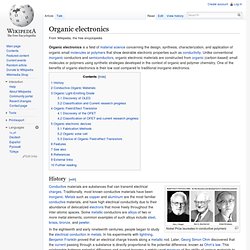

Organic electronics. Organic electronics is a field of material science concerning the design, synthesis, characterization, and application of organic small molecules or polymers that show desirable electronic properties such as conductivity.

Unlike conventional inorganic conductors and semiconductors, organic electronic materials are constructed from organic (carbon-based) small molecules or polymers using synthetic strategies developed in the context of organic and polymer chemistry. One of the benefits of organic electronics is their low cost compared to traditional inorganic electronics.
History[edit] Nobel Prize laureates in conductive polymers Conductive materials are substances that can transmit electrical charges. Henry Letheby discovered the earliest known organic conductive material in 1862. More recent work has expanded the range of known organic conductive materials. Conductive plastics have recently undergone development for applications in industry. Conductive Organic Materials[edit] J.E. Just One Word. First, a large plastic sheet is coated with an organic compound sensitive to light from a laser used in the printing process.

Next comes a layer of conductive polymer that will form the circuit's gate electrodes and interconnects. The coated plastic sheet is then pressed to a second piece of plastic that will act as the circuit substrate, and the two are run through an apparatus that acts like an industrial laser printer. Wherever the laser strikes, the sensitive compound evaporates, pushing the conductive polymer onto the circuit substrate where it sticks. To build an active-matrix backplane (complete except for the organic semiconductor, which is evaporated on later), the process is repeated using a plastic sheet covered in the gate dielectric and another coated in conductive polymer for the source and drain electrodes.
The technique prints all three layers sequentially on a 5-m sheet in about three minutes. To be fair, organic materials are not the only hope for flexible circuits. The Plastic Processor. Take a bow, flexible chip.

This week at the International Solid-State Circuits Conference, in San Francisco, European researchers will introduce the world’s first microprocessor made with organic semiconductors. The 4000-transistor, 8-bit logic circuit has the processing power of only a 1970s-era silicon model, but it has a key advantage—it can bend. The device’s designers say the chip could lead the way to cheaper flexible displays and sensors. Wrapped around pipes, for example, sheets of sensors with these processors could record average water pressure, and wrapped around food and pharmaceuticals, they might indicate that your tuna is rancid or that you forgot to take your pills. The key to the chip’s design was taming the somewhat unruly organic transistor, says Jan Genoe, a polymer and molecular electronics researcher at Belgian nanotech research center Imec, in Leuven, who led the research with colleague Kris Myny. Nanoscale Processing Leads Scientists To Integrate Silicon Chips into Living Cells. In a report in Nanowerk, Researchers at the Micro and Nanosystems Department, Instituto de Microelectrónica de Barcelona IMB-CNM (CSIC), led by José Antonio Plaza have successfully implanted silicon chips into living cells and manage to keep the cells alive for seven days.

The research was originally published in the Wiley journal, Small. The aim of the work was to demonstrate how our ability to create 3D-structred silicon chips on the scale of nanoparticles could enable intracellular sensors. Of course, this is a preliminary step to such possibilities since the cells were not integrated into a larger living organism in which we might see phagocytes attack the chip-impregnated cells, for instance. Or how the chips might actually transmit to an outside receiver the data it had collected inside the cell. But as we said this is a preliminary step.
Organic Transistor Could Outshine OLEDs. 4 May 2010—A transistor that emits light and is made from organic materials could lead to cheaper digital displays and fast-switching light sources on computer chips, according to the researchers who built it.

Small displays made from diodes of the same type of materials (organic light-emitting diodes, or OLEDs) are already in commercial production, but the transistor design could improve on those and lead to applications where OLEDs can’t go. The new organic light-emitting transistor (OLET) is much more efficient than previous designs. It has an external quantum efficiency—a key measure of how much light comes out per charge carrier pumped in—of 5 percent.
An OLED based on the same material has a quantum efficiency of only 2 percent. Previous OLET designs had an efficiency of only 0.6 percent. The key to higher efficiency is a three-layer structure, with thin films stacked on top of one another.